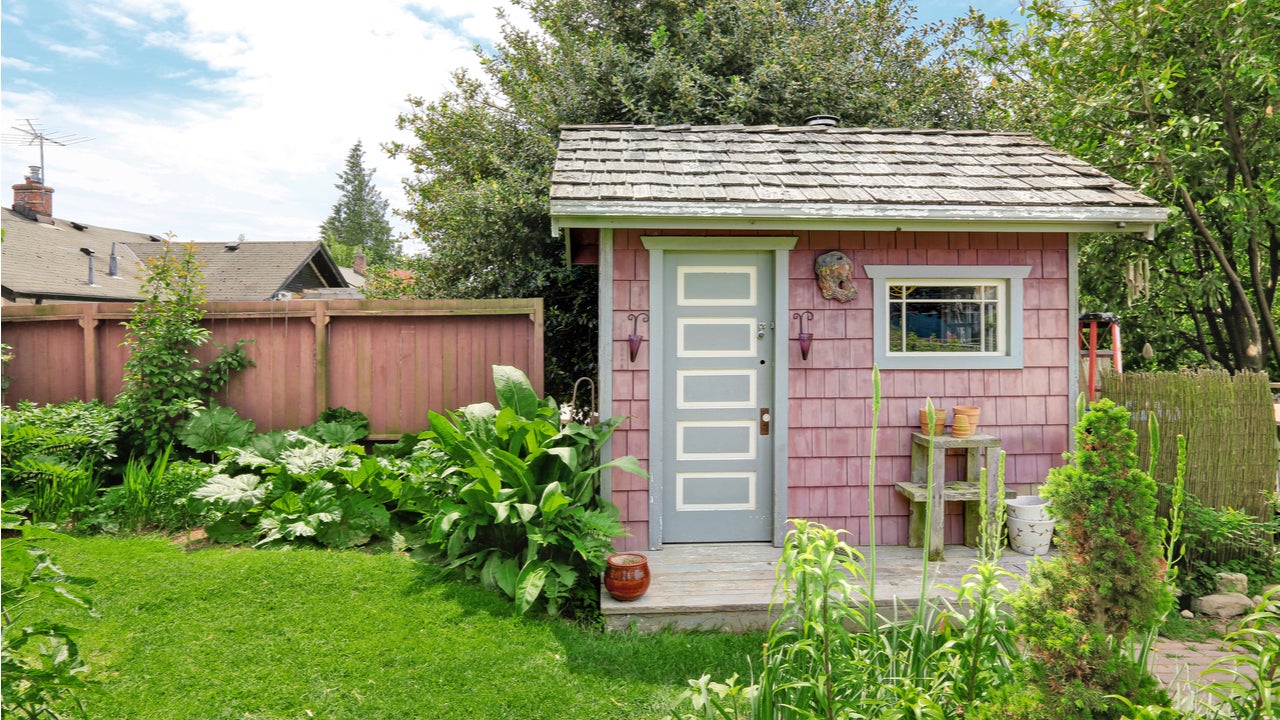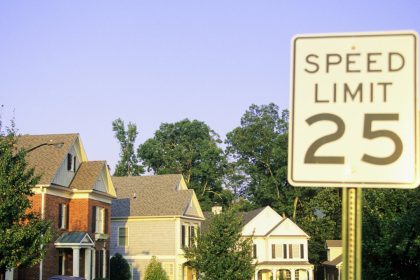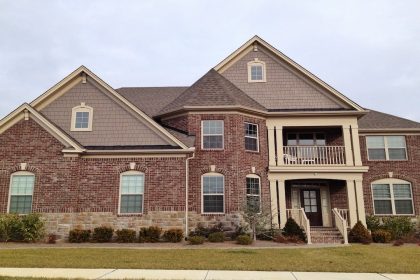Key takeaways
- Garages and other outbuildings can enhance your home’s fair market value, especially if they increase the usable or liveable space.
- Ways to finance a detached structure include a HELOC, home equity loan, cash-out refinance and renovation loan.
- There are pros and cons to each financing option, based on its interest rate, the size of your home equity stake and other factors.
- Costs to add an outbuilding can vary widely, depending largely on size, features and the need for professional labor.
Want to add space and value to your home? We have one word for you: outbuilding.
Whether it’s a garage, workshop or accessory dwelling unit (ADU), the presence of a detached structure on your property could positively impact its worth.
Outbuildings can be expensive to construct, but there are financing options available. Let’s look at the ins and outs of these add-ons.
Should you borrow to finance a garage or detached structure?
You can, of course, pay for your detached structure in cash, but considering that one can cost well into the five figures — even over $100,000 in some elaborate cases — that might not be the most feasible option.
Some scenarios when it might make sense to finance include:
- If you don’t have all of the cash needed to pay the full cost of the project.
- If you have equity in your home that can be tapped to fund the project.
- If you have a solid credit score that’ll get you a competitive interest rate.
- If you have a plan to pay back the money and are disciplined about doing so.
How to finance your additions
Fortunately, there are plenty of ways to finance your addition that can be budget-friendly. Many personal loans come with repayment terms of one to 10 years, while home equity loans and home equity lines of credit (HELOCs) could have repayment periods of up to 30 years. With both options, you’ll be responsible for making consistent monthly payments. Bear in mind, you’ll be paying back interest on top of your loan amount.
HELOCs
Home equity lines of credit (HELOCs) give you a line of credit to pull from (essentially like a credit card) based on the amount of equity you have in the home. You usually have 10 years to borrow from your line, and you’ll repay what you borrowed (plus interest) over the following 20 years or so.
Keep in mind that HELOCs have variable interest rates — they reflect moves by the Federal Reserve to raise or lower rates — so the amount of interest you pay could rise over time.
A HELOC could be a good option if:
- You have great credit that allows you to score the best possible interest rate.
- You have substantial equity in your home.
- You don’t know exactly how much money you need for your project or how long it’ll take to do.
A HELOC could be a bad option if:
- Your income isn’t reliable, and increases in monthly minimums due could be problematic.
- You plan on selling your home soon, which would require paying off the outstanding balance immediately.
- You lack strong credit.
Home equity loan
Like a HELOC, a home equity loan uses the equity you’ve built up in your home. However, a home equity loan is an installment loan, meaning you receive all of your funds at once and repay it in equal monthly installments.
Typically, the loan amount you can borrow is no more than 80-85 percent of your home equity. You’ll have to start making payments right away, but your interest rate and the monthly payment will never change.
A home equity loan could be a good option if:
- You need all of your funds upfront and/or you know the exact amount you’ll need.
- You have substantial equity in your home.
- You prefer fixed interest rates and monthly payments.
A home equity loan could be a bad option if:
- You don’t have at least 80 percent equity in your home.
- Your financing needs change throughout the construction project.
- You don’t have strong credit.
Cash-out mortgage refinance
A cash-out mortgage refinance is the process of replacing your existing home mortgage with a new, bigger mortgage, then taking out the difference in cash. You can use this cash for any purpose.
Keep in mind, a cash-out refinance completely replaces your existing mortgage and may change your repayment timeline or monthly payments. It’s generally best to do it only if you can get a lower interest rate, or improve the terms in some other way.
As with your original mortgage, your monthly payments will be steady (assuming you opt for a fixed-rate loan). “In this way, the cash-out refi provides protection from rising rates in the future, which is an advantage over a HELOC,” says Glenn Brunker, president of Ally Home. The cash-out refi’s interest rates may be lower than those of home equity loans, too.
A cash-out mortgage refinance could be a good option if:
- You can obtain a better interest rate than you currently have on your mortgage.
- You want to revise or change your current mortgage terms.
A cash-out mortgage refinance could be a bad option if:
- You don’t qualify for a lower rate than your existing mortgage loan.
- You prefer your current mortgage terms.
Personal loans
A personal loan can also be a solid option if you’re looking to add a detached structure to your property. The good thing about these loans (when compared to a home equity loan, for example) is that they don’t require collateral. And the proceeds from a personal loan can generally be made available very quickly, sometimes in as little as a few days.
The drawback, though, is that they typically have higher interest rates than home equity products. They also come with shorter terms, so you’ll likely need to repay the money faster.
The amount you can borrow for a personal loan (and the interest rate you’ll get on it) will depend largely on your credit score, income and other debts. So if your credit is less than stellar, you might consider financing your project another way.
A personal loan could be a good option if:
- You don’t want to put your home on the line by using it as collateral.
- You need the money quickly.
- You have a solid credit score or a creditworthy co-signer.
A personal loan could be a bad option if:
- You need to repay the loan over a long period.
- You lack strong credit, and so won’t get the most competitive rate.
Home renovation loans: FHA, Freddie Mac, Fannie Mae
Renovation loans can be good choices when looking to improve your home. Often these products are combination mortgages and loans: that is, they simultaneously provide financing both to buy a residential property and to renovate it — which includes building new detached structures or upgrading old ones.
FHA 203(k) loan
One go-to is the Federal Housing Administration (FHA)’s 203(k) loan. Because they’re backed by the FHA, these loans come with low interest rates and aren’t too hard to qualify for.
The FHA also allows for 203(k) refinancing, which would allow you to refinance your existing mortgage into a 203(k) loan. This would give you the funds you need to pay for your improvements while also keeping you to a single monthly payment.
However, like all FHA loans, your property must meet minimum requirements to be eligible for the 203(k) refinancing program. For example, the detached structure must meet the program’s list of eligible activities and your home’s value must be within FHA’s mortgage limit.
Freddie Mac CHOICERenovation Loan/Fannie Mae HomeStyle Renovation loan
There are also private sector loans for renovations and combo purchase/rehabs. The Freddie Mac CHOICERenovation loan is one that allows you to both buy and rebuild. The Fannie Mae HomeStyle Renovation loan or mortgage is another.
In general, these loans are designed for any home renovation or repair that is affixed to the property and adds value to it. Detached structures count, as long as they are permanent fixtures.
Fannie Mae and Freddie Mac may require tougher qualifications than a government-backed loan: higher credit scores, bigger down payments. For instance, Fannie Mae credit checks are fairly robust. Not only will the lender check your credit score, but also evaluate how often you carry a credit balance versus paying the balance off each month. You must complete renovations within 450 days of the note date (roughly 15 months) for both Fannie and Freddie loans.
A home renovation loan could be a good option if:
- You’re buying a place that needs substantial rehabbing.
- You want to refinance your existing mortgage.
- You have your plans ready and are prepared to start renovations quickly.
A home renovation loan could be a bad option if:
- Your home/property or construction project doesn’t meet the FHA loan requirements, or you don’t meet the lender credit requirements
- You’re not ready to begin work within 30 days of closing.
- The project is likely to take longer the designated completion time period.
The pros and cons of financing add-ons
As with any major purchase or expense, there are pros and cons to using a loan to build a garage or other outbuilding. Loans offer a lump sum windfall that make it easy to get started on an upgrade — but it may be wiser, in some cases, to use savings or other types of debt.
Pros
- Several options offer better, cheaper ways to borrow, especially compared to credit cards.
- You can reserve your savings, have cash available for other expenses.
- Loan interest may be tax-deductible, if you itemize on your tax return.
Cons
- You have to meet approval requirements and qualifications.
- Applying for a loan can be time-consuming and delay the start of your project.
- The interest you pay can significantly increase the overall cost of your project.
- You are incurring additional debt that can hurt your financial profile.
Cost expectations
While simple structures cost as little as a few thousand dollars, more complex ones can run into the six figures, especially if you get all the bells and whistles.
The table below outlines the typical cost of adding various detached structures to your home.
| Type of structure | Normal cost range | Average cost | Low end | High end |
| Carport | $3,094 to $9,436 | $6,229 | $300 | $25,000 |
| Garage | $16,810 to $42,196 | $29,488 | $5,000 | $70,000 |
| Detached garage | $19,200 to $33,600 | $26,400 | $9,600 | $75,600 |
| ADU | $60,000 to $285,000 | $180,000 | $40,000 | $360,000 |
| Storage shed | $800 to $18,000 | $4,000 | $300 | $30,000 |
| Barn | $1,595 to $5,306 | $3,392 | $400 | $10,000 |
Source: Angi
Overall, the cost of each outbuilding will depend on the following factors:
- Your use of professional contractors
- Required site preparation (to remove trees or level the land)
- Presence of windows or doors
- Electrical and plumbing needs
- Nature of roofing, framing and siding materials (metal costs more than wood)
- Any permits required
- The foundation (will you need a concrete foundation poured?)
- Any paint, stain or decorative elements
How to estimate your costs
The expense of building a detached structure depends on the size of the structure you hope to build, as well as the materials and finishes you select. Several home improvement sites can help you outline the materials your project will involve and what these items will cost. These sites detail how much a project may run you per square foot, as well as what you can expect to pay for permits, roofing materials, drywall, framing, different types of foundations, siding materials and other expenses.
Also significant: If you are using a prefab kit — easier if you’re doing it yourself — or aiming to construct from scratch.
If you decide to skip the DIY route and hire a contractor to handle your home addition project, it’s important to have a firm understanding of what you hope to achieve, says David Steckel, a former home expert with Thumbtack, a home renovation site and contractor search service.
“Do you want to have a small office space or do you want to create a new living area that can be rented out?” he asks. “This goal is translated by the general contractor into a scope of work budget, which provides an explicit, line by line, description of what work is going to be completed, a rough estimate as to what level of finish, and a cost for everything.”
When reviewing potential contractors, do background checks with the Better Business Bureau and check that the company has a contractor’s license. It’s also a good idea to obtain references from previous clients or read Yelp and Google reviews.
How much value can a detached structure add to my home?
It’s difficult to estimate what kind of return on investment you can expect by adding a detached structure to your home. But it’s safe to assume that a well-built garage, carport, shed/barn or ADU will increase your property’s value to some extent. Anything that enhances the living space or functionality of the property generally does.
It can also generate income, if it’s something like an ADU that can be rented out. “Now, the same property … goes for a premium in the market,” explains Doug Greene, owner of Philadelphia-based home buying company Signature Properties. “If you can add an additional $1,000 to $2,000 per month in rental income, this can amplify the price point. Another $1,000 in rent, at a 5 percent cap rate, can add $150K+ to the property’s overall value.”
When it comes to other types of outbuildings, the extent to which they can increase your home’s value will depend on their size and nature, and of course the quality with which they’re built.
A new garage can increase your home’s value by $12,800 to $33,200 on average, according to Angi. But a multi-vehicle garage will likely increase the value of your home more than a one-car garage, and attached garages can have a higher return on investment than detached garages.
Return on investment reflects the cost of a project, but the nature of the project itself is more important. Austin Beachy, who handles marketing at Sheds Unlimited in Morgantown, Penn., notes that a new shed can add decent value but not as much as a garage. “For example, if the cost to build a new shed is $10,000, it could add between $5,000 and $7,000, or 50 to 70 percent of the total building cost, to the value of your home,” he explains. “A new garage, on the other hand, can provide a greater return on investment in the range of 60 percent to 80 percent of the cost of the garage’s construction.”
Bottom line on financing outbuildings
Borrowing money to pay for an outbuilding could be a good idea if you have a plan in place to pay off your debt.
Fortunately, there are many ways of financing a garage, ADU, barn or shed. But it’s important to estimate your labor and material costs thoroughly to determine how much you need to borrow. Shop around to find the right contractors and materials, and compare bids carefully.
Do the same with your financing: It’s wise to shop around with a few home equity lenders. Doing so will allow you to compare rates and find the cheapest way to finance your detached structure. With the right planning and preparation, you can better ensure a satisfactory outcome on the addition, while adding to the versatility and value of your property.
Additional reporting by Elizabeth Aldrich
Read the full article here
















